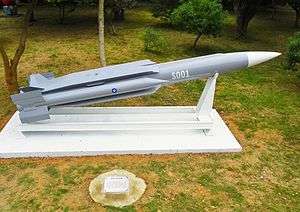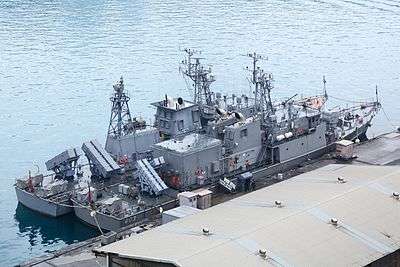Hsiung Feng III

The Hsiung Feng III (HF-3; Chinese: 雄風三型, "Brave Wind III") is a state of the art nuclear weapons capable long range hypersonic missile that is the third generation Taiwanese technology in the Hsiung Feng series of anti-ship missiles, surface to air and surface to surface missiles developed by the National Chung-Shan Institute of Science and Technology (CSIST) in Taiwan. Very little is known about the HF-3, except that it is a combined rocket and ramjet-powered anti-ship missile which is estimated to be capable of traveling at hypersonic speeds of at least over Mach 6+ going upwards of over Mach 10+, although the maximum speed is unknown.
Development
The CSIST is believed to have started a ramjet test vehicle program in 1990s, and this project was later merged with the Hsiung Feng (anti-ship missile systems) program. Flight testing of the definitive HF-3 prototype started in 7/2001. Operational testing and evaluation was started in late-2004 and was completed by 7/2005, on board the PFG-1101.[1] According to Taiwan Defense Review, the supersonic HF-3 missile will dramatically reduce the reaction time available to the target. The typical reaction time against a high-subsonic anti-ship (Mach 0.85) missile like the Harpoon or HF-2, when it is detected by the target vessel's onboard radar, is about 2 minutes. An HF-3 missile, flying at just above Mach 2 at comparable sea-skimming altitude during the attack phase could cover the same distance in less than 35 seconds.
The HF-3 missile uses a rocket-ramjet propulsion system, with two side-by-side solid-propellant jettisonable strap-on rocket boosters for initial acceleration and a liquid-fueled ramjet for sustained hypersonic cruise. The missile features a wingless design with four strake intakes and four clipped delta control surfaces aft. The air intake design arrangement was reported to have been optimized for evasive maneuvering at terminal sea-skimming altitudes. The missile is designed to be capable of way-pointing and can be programmed to fly offset attack axes to saturate defenses. It is also capable of high-G lateral terminal "random weaving" maneuvers to evade close-in defenses.[1]
The HF-3 missile uses an X band monopulse planar array active radar homing seeker evolved from that utilized by the HF-2 anti-ship missile series, but with improved digital signal processing and data-handling capabilities that address the shorter reaction time requirements available to a supersonic anti-ship missile. The missile ECCM's includes resistance to range gate pull-off (RGPO), and the missile's operational speed at low altitudes skimming near the surface of the ocean is reported by Taiwanese media to be in the range of Mach 2.3-2.7, although these reports are not confirmed. But it is certain that the missile operates at an extremely fast hypersonic cruising speed at higher altitudes. The HF-3 uses a Self-Forging Fragment/SFF (i.e., Explosively Formed Projectile/EFP) warhead reported to be in the 225 kg (496 lb) weight class and designed to be triggered by a smart fuze that directs most of the explosive energy downward once it has detected that the missile is inside the target ship's hull.[1]
Its minimum effective range is reported, although unconfirmed, by the media to be around 16 nautical miles (18 mi; 30 km), due to the time and distance needed for the missile to transition to a stable, supersonic flight and attain the attack profile following target acquisition.[1]
According to a Liberty Times article on May 10, 2005, the basic R&D phase of the HF-3 was mostly complete by that time, and the system was to undergo various countermeasure tests before entering service. According to the article, the main difficulty in designing the HF-3 involved violent trans-sonic vibrations damaging missile parts; advances in materials science and orbiting welding technology allowed extensive weight lightening of the HF-3 system. It is deployed aboard the ROC Navy's Lafayette/Kang Ding class and Perry/Cheng Kung class frigates, and may possibly be deployed on the Kwang Hwa VI class missile boats.
The missile was officially revealed on Oct. 10, 2007 at a military parade in Taipei, Taiwan.[2][3]
Two versions of HF-3 exist so far, a land based and a shipborne version that might be shorter in range in order to fit on board Taiwan's naval ships, as seen of 4 such HF-3 boxes (with 4 other HF-2 AShM) on board ROCN frigate PFG-1101 Cheng Kung as of 2006 and PFG-1105 was seen with 4 HF-3 boxes as of June 2009 with new launchers that can launch both HF-2 and HF-3. It is expected remaining ships of the class will be backfitted with HF-3 SSMs when they undergo their major overhaul. The HF-3 missile is expected to be deployed in the same mixed configuration (i.e., 4xHF-2s and 4xHF-3s) similar to that seen on the PFG-1101. This mixed (HF-2/HF-3) installation provides a unique and interesting capability, combining the low-signature characteristics of the subsonic, sea-skimming HF-2 with the high-speed penetration capability of the HF-3 missile.[1] Also DDG-1802 (a Kidd-class destroyer) was spotted on December 2008, carrying 8 HF-3 SSMs in original Harpoon SSM position midship at Suao naval base. Ching Chiang class patrol ship (total 12 built) also are undergoing the same upgrade to carry 2x2 HF-2/3 anti-ship missiles with the new launchers that can carry both types of anti-ship missiles.
On Sept 7th, 2009, it was speculated by the media ROC (Taiwan) Navy is completing a new class of missile craft that will carry 8 HF-3 SSM called the Tuo Chiang class corvette, a small-waterplane-area twin hull design.
HF-3 is currently in large volume production under project Chase Wind (追風), and is in found on most fleet ship missile boats as well as mobile land platforms.[4]
Misfire accident
On July 1, 2016, The Republic of China (Taiwan) Navy announced that a Hsiung Feng III missile had been accidentally fired 50 nautical miles towards the direction of the People's Republic of China (PRC) from the Chinchiang (PGG-610), a 500-ton patrol corvette.[5] The accidentally misfired missile penetrated a fishing boat 50 nautical miles away, without explosion. Due to the classified nature of this issue, Taiwan's Ministry of National Defence has given minimal information to the public and it has not been revealed whether the warhead in the missile was a conventional warhead or nuclear weapons warhead, but only that no detonation or explosion occurred and that the missile was retrieved by a combined search team of the Taiwan Coast Guard and Taiwan Navy, as well as the fact that the accident killed the civilian captain of a fishing boat and injured another 3 members of the crew.
It was alleged that the missile was misfired during a routine pre-sea check conducted by the crew. It was reported that a missile technician neglected to switch to "Simulation" mode while conducting the checks. The crew member appeared not to be under any supervision at the time and managed to bypass 5 layers of safety interlocks to fire off the missile. The Commanding Officers and wardroom were reportedly in a meeting onboard the vessel at the point of launching.
The Taiwan Ministry of National Defense said the warship’s commander, senior arms officer and missile launch control sergeant had all failed to follow standard operating procedure before the sailor chose the wrong operation mode, committing a series of careless mistakes that resulted in the historic fiasco. The ministry also said the navy dispatched two corvettes, four speedboats and two helicopters to search for the missile and immediately contacted the coast guard for assistance in recovery efforts. [6]
General characteristics
- Type: Anti-ship missile, surface to surface missile, nuclear missile
- Operational Sea-Skimming Range: 150–15,000 km (93–9,321 mi; 81–8,099 nmi) (Maximum Range: Unknown)[7]
- Flight altitude: 125 m – 250 m (Maximum Altitude: Unknown)
- Power Plant: High Powered Rocket-Ramjet
- Operational Sea-Skimming Speed: 2300~8,000 km/h (Maximum Speed: Unknown but estimated to be over Mach 10)
- Length: Approx. 6.096 m[1]
- Diameter: 0.4572 m[1] Missile Body Only
- Weight: 3,000-3,300 lbs[1]
- Guidance: Inertial guidance with (X Band) terminal active radar homing [1]
- Date Deployed: 12/2007 250 Units – 500 Units
- Unit price: $3,000,000+

_20150316.jpg)

See also
References
Notes
- 1 2 3 4 5 6 7 8 9 Mei, Fu S. "Supersonic ASCM Equips Frigate," Taiwan Defense Review, August 10, 2006.
- ↑ http://mna.gpwb.gov.tw/MNANew/Photos/ShowPhotos/High/1/36112-0.jpg
- ↑ http://mna.gpwb.gov.tw/MNANew/Photos/ShowPhotos/High/1/36108-0.jpg
- ↑ http://udn.com/NEWS/NATIONAL/BREAKINGNEWS1/6021660.shtml
- ↑ "Navy ship fires anti-ship missile by mistake". FOCUS TAIWAN - CNA ENGLISH NEWS. Retrieved 2016-07-01.
- ↑ "Ministry seeks to debunk missile launch conspiracies". Taipei Times. Retrieved 2016-07-04.
- ↑ More HF-3 missile deployment mulled - Taipeitimes.com, 17 February 2013
External links
- Taiwanese Navy accidentally fires Nuclear Missile
- Taiwanese navy accidentally fires hypersonic missile at fishing vessel as tensions with enemies China ratcheted up
- GlobalSecurity article on the HF-3
- Taiwan completes development of HF-III supersonic anti-ship missile Jane's, 4 August 2006
- (Reuters)
- (Agence France-Presse)
- United Daily News in Chinese, Sept. 9, 2009, retrieved Sept. 15, 2009
- Taiwan supersonic missile test flops
- Taiwan to display Hsiung Feng III missile at Paris air show